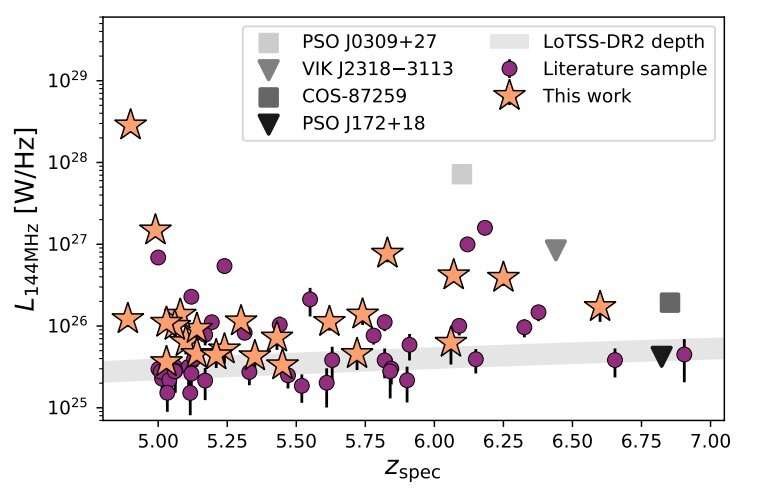Radio luminosities at 144 MHz of newly discovered quasars in this work compared to the literature sample of known high-redshift quasars detected in LoTSS-DR2. Credit: Gloudemans et al., 2022.
By analyzing the data from the Dark Energy Spectroscopic Instrument (DESI) Legacy Imaging Surveys and from the LOFAR Two-meter Sky Survey (LoTSS), an international team of astronomers has made a rare finding—the detection of 20 new radio-bright high-redshift quasars. The discovery is reported in a research paper published October 4 on the arXiv pre-print server.
Quasars, or quasi-stellar objects (QSOs), are extremely luminous active galactic nuclei (AGN) containing supermassive central black holes with accretion disks. Their redshifts are measured from the strong spectral lines that dominate their visible and ultraviolet spectra.
Astronomers are especially interested in finding new high-redshift quasars (at redshift higher than 5.0) as they are the most luminous and most distant compact objects in the observable universe. Spectra of such QSOs can be used to estimate the mass of supermassive black holes that constrain the evolution and formation models of quasars. Moreover, high-redshift QSOs that are also radio-bright are unique signposts of supermassive black hole activity in the early universe.
Now, a group of astronomers led by Anniek Joan Gloudemans of Leiden University in the Netherlands, reports the detection of new, rare, high-redshift quasars that are bright at radio wavelengths. The discovery was made as part of a campaign to search for radio-bright high-redshift QSOs by combining an optical color cut technique using the Legacy Surveys with LoTSS-DR2 radio detections.
"We have performed spectroscopic follow-ups for 80 of our candidates, which lead to the confirmation of 20 new quasars (and the independent confirmation of four recent confirmed high-z quasars) between 4.9 ≤ z ≤ 6.6 and a doubling of the sample of known radio-loud quasars in this epoch," the researchers wrote in the paper.
By analyzing the optical and near-infrared colors, Lyman-alpha emission line properties, and dust reddening of the newfound quasars, the astronomers found that they do not deviate from the known radio-quiet quasar population. This suggests that the optical properties of the radio-loud and radio-quiet quasar population at high redshift are similar.
The researchers underlined that their discovery demonstrates the potential for efficiently identifying new high-redshift quasar populations through next generation radio continuum surveys. They added that their new quasar sample probes on average fainter rest-frame ultraviolet luminosities and brighter radio luminosities than the previously known quasar population.
In concluding remarks, the authors of the paper proposed further studies of the newfound quasars in order to determine the active galactic nucleus (AGN) and host galaxy properties of these objects. They noted that their radio spectra need to be constrained to be able to study the radio emission mechanisms of the AGN.
The researchers hope that the WEAVE instrument—a recently built multifiber spectrograph on the William Herschel Telescope on La Palma—will help them find and investigate more high-redshift radio sources, including quasars.
More information: A. J. Gloudemans et al, Discovery of 24 radio-bright quasars at 4.9 ≤ z ≤ 6.6 using low-frequency radio observations. arXiv:2210.01811v1 [astro-ph.GA], arxiv.org/abs/2210.01811
© 2022 Science X Network
























